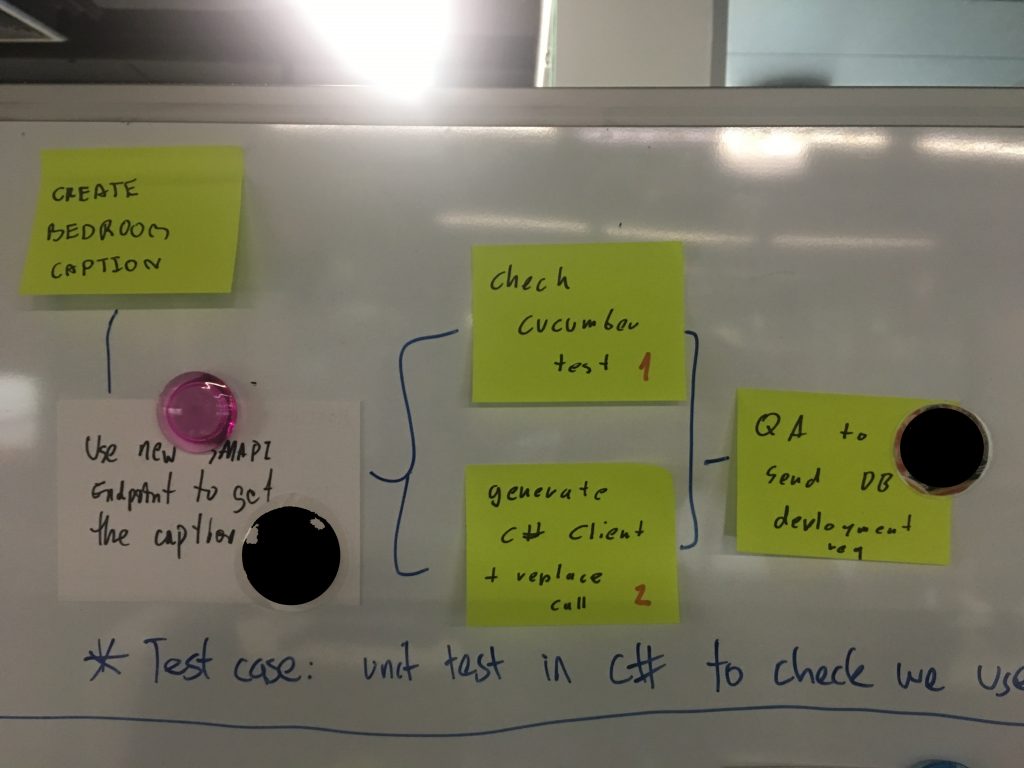You know how you can automate everything but some things just shouldn’t be. Well, this process is kind-of one of those things. I’m personally not 100% convinced that JIRA/Trello/Online Scrum Board XXX is better than your plain old whiteboard. Why do I make such a bold claim? I can explain, honestly! Now, what I’m not saying is that the whiteboard is better for project management. Because that’s another beast entirely. What I’m really talking about is a sprint board.
Task Breakdown
As an engineer, we usually have to break down larger stories into tasks. These can then be split up amongst your team and you can divide and conquer, right? Well, here’s where a whiteboard shines. Task breakdown can be visually designed on a whiteboard and is quick. Oh – you want to group serverside tasks together under a story? No problem. Put the post-it notes in the same area on the board and draw a circle around them (just an idea). What about frontend? Same thing! You can easily visually break down the story into smaller chunks without the effort of scrolling.
Whereas, with an online board management software like JIRA/Trello/Whatever, it’s much harder to maintain. They just go into lists. Maybe you add some sort of visual tag to them or change the colour. Sure that works. But it’s a lot more work to scroll through this list than glancing on a whiteboard. And only one person can enter the tasks – whereas on a whiteboard anyone can pick up a pen and write on a post-it note.

We were also introduced to drawing dependencies on your board for tasks that depend on other tasks to be completed before they can be picked up. For example, you may need to create a mock API endpoint before you can start to work on calling the API on the client-side. You can draw a dependency line to that. That way, you and your colleagues know what tasks they can pick up next and which tasks to avoid. Can you do that with these online boards?
Daily Scrum
I know that not everyone will have a daily scrum – so this may be irrelevant to some people. But with a physical whiteboard, you can actually see progress being made as people tick or move around the tasks they’ve done. You’re also right next to the board. It’s not some monitor that you all gather around. And blocking tasks? You can just move around something bright to constantly let the team know you’re blocked. It’s easy. We’re made for moving around physical things.
On a side note: Isn’t it much better to stand up and go to a board than crowd around a computer or do stand up on slack? Just for general exercise and well-being.
What’s more effective?
For the case of reporting, JIRA will shine almost every time. It’s automatic. It can track time. It’s great in terms of those things. But for every day scrum/kanban/stand-ups, a whiteboard (or any physical board) will shine. You can draw things. You can link whatever you want. You can easily move tasks around. You don’t need to follow any “flow”. You can use your imagination.
How often do you report? I would say – not as often as you stand in front of the board. So it’s my opinion that you embrace the old-school whiteboard and let your imagination run wild. Your progress doesn’t need to be moulded to a particular “flow”. If you need to track how much work is done – then just take a photo – or count the tasks in the done column – or count the tasks ticked off. Reporting should not dictate your teams daily flow.
Leave a Reply